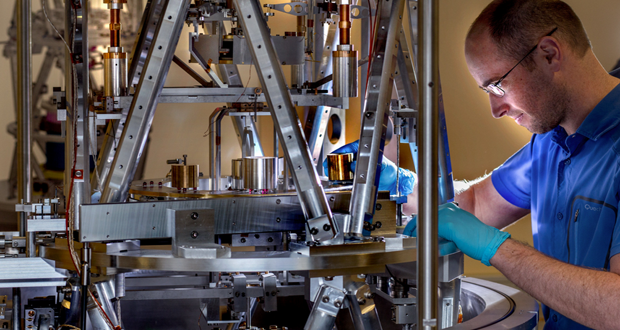Science says goodbye to the original kilogram
20 May 2019 by Evoluted New Media
The metal block that represents the global standard of the kilogram has been replaced after 130 years.
As of World Metrology Day (Monday, May 20), redefined standards of the International System of Measurement (SI) means a kilogram is now expressed in terms of fundamental constants that can be observed in the natural world, rather than a physical object.
[caption id="attachment_95428" align="alignleft" width="299"] Kibble Balance. Image: BIPM[/caption]
Kibble Balance. Image: BIPM[/caption]
The changes, voted on by global representatives last November, will ensure the kilogram remains stable and will enable more accurate mass measurements in the future.
Dr Ian Robinson at the National Physical Laboratory, said: “There will be no change to the mass scale currently used in trade and industry, but by using a universal constant of nature to ensure the long term stability of the kilogram, we are both reunifying the SI and setting the stage for robust, reliable science that could pave the way for new ideas and inventions.”
The definition of kilogram will now be based on the Planck constant, a constant observed in the natural world that is inherently stable. It uses the Kibble Balance, a physical instrument that measures mass using electromagnetic and quantum techniques.
Since 1889, the kilogram has been defined by the International Prototype of the Kilogram (IPK), a metal block made of an alloy of 90% platinum and 10% iridium, contained within glass bells in a vault in Saint-Cloud, France.
[caption id="attachment_95425" align="alignleft" width="232"] Dr Ian Robinson worked on the development of the Kibble Balance with the late Dr Bryan Kibble at the National Physical Laboratory, the UK’s national measurement standards laboratory.[/caption]
Dr Ian Robinson worked on the development of the Kibble Balance with the late Dr Bryan Kibble at the National Physical Laboratory, the UK’s national measurement standards laboratory.[/caption]
Different countries have used their own prototype kilograms that were calibrated back to the IPK, to ensure mass measurements were consistent around the world.
However, the IPK can gain mass over time due to adsorption of atmospheric contamination onto its surface. Changes in the IPK's mass over time can be deduced by comparing it to official copies, but this process is rarely undertaken and does not have the accuracy of the new standard.
Dr Richard Brown, Head of Metrology at the National Physical Laboratory, said: “The revised SI future proofs our measurement system so that we are ready for all future technological and scientific advances such as 5G networks, quantum technologies, and other innovations that we are yet to imagine.”
As well as the kilogram, the Ampere will now be defined using the elementary charge (e), a fixed value; the Kelvin will be defined using the Boltzmann constant (kB); while the mole will be based on the Avogadro constant (NA).











